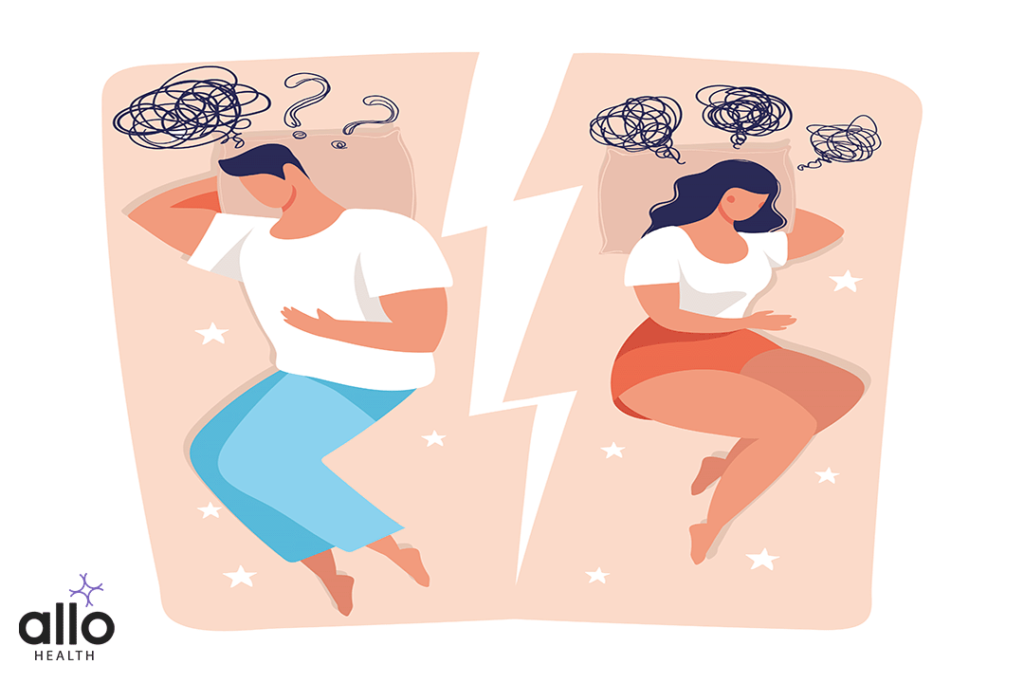4 Types Of Sexual Dysfunctions

Allo Health is dedicated to personalized well-being, offering support and trusted information tailored to individual health goals. The platform emphasizes human-generated content, led by a distinguished medical team of experts, including physicians and sexual health specialists. Their commitment to credibility involves rigorous fact-checking, authoritative research, and continuous updates to ensure accurate, up-to-date information. Allo Health's unique approach goes beyond conventional platforms, providing expert-led insights and a continuous commitment to excellence, with user feedback playing a crucial role in shaping the platform's authoritative voice.

Dr Ooha is a graduate of AFMC and a practicing neuropsychiatrist. Over the last 5 years, she has worked with patients facing various psychiatric challenges ranging from Schizophrenia, Bipolar disorder and OCD to Anxiety disorders, ADHD, personality disorders and sexual problems. She has a keen interest in expanding her repertoire in the areas of Forensic Psychiatry, Child and Adolescent issues and Sexual Wellness with evidence-based approaches and further adding to the fount of knowledge with original research.
Why This Was Upated?
Our experts continually monitor the health and wellness space, and we update our articles when new information became available.
Updated on 25 May, 2024
- Article was updated as part of our commitment to diversity, equity, and inclusion.

"The following blog article provides general information and insights on various topics. However, it is important to note that the information presented is not intended as professional advice in any specific field or area. The content of this blog is for general educational and informational purposes only.
Book consultation
The content should not be interpreted as endorsement, recommendation, or guarantee of any product, service, or information mentioned. Readers are solely responsible for the decisions and actions they take based on the information provided in this blog. It is essential to exercise individual judgment, critical thinking, and personal responsibility when applying or implementing any information or suggestions discussed in the blog."
What Are Sexual Dysfunctions?
Sexual dysfunctions refer to a range of conditions that can affect a person’s ability to experience sexual pleasure or satisfaction. These conditions can be physical, psychological, or a combination of both – all of which can affect sexual function significantly.
Some common examples of sexual dysfunctions in men include erectile dysfunction (ED), and ejaculation disorders such as premature and delayed ejaculation. Erectile dysfunction, sometimes referred to as impotence, is the inability to achieve or maintain an erection. Premature ejaculation is when a man ejaculates too soon during sexual activity, while delayed ejaculation is when a man has difficulty reaching an orgasm or ejaculating at all.
In women, sexual dysfunctions can include conditions such as hypoactive sexual desire disorder (HSDD), sexual arousal disorder, and sexual pain disorders. HSDD is characterized by a lack of sexual desire, while sexual arousal disorder is the inability to become sexually aroused. Sexual pain disorders, such as dyspareunia and vaginismus, are characterized by pain during sexual activity.
There are many potential causes of sexual dysfunctions, including physical conditions, such as diabetes (high blood glucose levels) and heart disease, as well as psychological conditions, such as depression and anxiety. Hormonal imbalances, medications, and lifestyle factors, such as stress and lack of sleep, can also contribute to sexual dysfunctions.
Treatment options for sexual dysfunctions vary depending on the condition and its underlying cause. In some cases, medication or counseling may be recommended, while in other cases, lifestyle changes, such as exercise and stress management, may be helpful. In some cases, a combination of treatments may be most effective.
Sexual dysfunctions are common and can affect people of all ages and backgrounds. If you are experiencing any symptoms of a sexual dysfunction, we encourage you to speak with a healthcare professional or sexual healthcare expert to determine the cause and the best course of treatment for you. With the right support and care, it is possible to manage and improve sexual dysfunctions and regain a satisfying sex life.
Types Of Sexual Dysfunctions
Sexual disorders can affect any point of the sexual response cycle which are desire, excitement or orgasm/climax. The symptoms of sexual disorders cause can interfere with and disrupt individuals from having a good experience before, during, or after sex.
There are four categories in which sexual disorders are placed, all of which can impact both men and women. There can be an overlap between these and one disorder can cause another to arise. For example, a person who has concerns with getting aroused may end up losing desire after some time.
Sexual Desire Disorders
The disorders that fall under the category of desire disorders affect the sexual desire and/or interest of an individual. Commonly, it is referred to as disorders that affect the libido.
There are several types of sexual desire disorders, including:
Hypoactive Sexual Desire Disorder (HSDD)
Hypoactive Sexual Desire Disorder (HSDD) is a condition characterized by a lack of sexual desire or interest in sexual activity. This condition can cause significant distress and can negatively impact a person’s relationships and overall quality of life.
HSDD can affect both men and women and can be caused by a variety of factors, including hormonal imbalances, psychological concerns, and relationship concerns. Certain medical conditions and medications can also contribute to the development of HSDD.
Symptoms of HSDD include a lack of sexual thoughts or fantasies, a lack of interest in sexual activity, and difficulty becoming aroused. These symptoms must be present for at least six months in order for a diagnosis of HSDD to be made.
Treatment for HSDD can include therapy, medication, and lifestyle changes. Therapy can help individuals address underlying psychological concerns that may be contributing to their HSDD. Medications such as testosterone and flibanserin can also be used to increase sexual desire. Lifestyle changes such as exercise, stress management, and a healthy diet can also improve sexual function.
Sexual Aversion Disorder
Sexual Aversion Disorder (SAD) is a condition characterized by a strong, persistent fear and avoidance of sexual contact. This can include physical touch, sexual activity, or even thoughts or fantasies related to sex.
Symptoms of SAD may include a physical response, such as sweating or shaking, when confronted with sexual situations, as well as avoidance of sexual contact or activity. SAD can also manifest as a lack of sexual desire or interest.
The cause of SAD is not fully understood, but it is believed to be related to past traumatic experiences or negative associations with sex. It can also be linked to other mental health conditions, such as anxiety or depression.
Treatment for SAD typically involves therapy, such as cognitive-behavioral therapy or exposure therapy, as well as medication, such as antidepressants. Medications like antidepressants, anti-anxiety medications, and hormones can help ease symptoms of SAD.
Female Sexual Interest/Arousal Disorder (FSIAD)
Female Sexual Interest/Arousal Disorder (FSIAD) is a condition characterized by a lack of sexual interest or desire, and difficulty becoming sexually aroused. FSIAD can have a significant impact on a woman’s quality of life and can cause distress in her relationships. The causes of FSIAD are not fully understood, but a combination of physical, psychological, and social factors may play a role.
Some physical causes of FSIAD include hormonal imbalances, chronic disease illnesses, and certain medications. Psychological causes may include depression, anxiety, and stress. Social factors, such as relationship concerns or a history of sexual trauma, may also contribute to FSIAD.
Symptoms of FSIAD include a lack of sexual desire or interest, difficulty becoming sexually aroused, and difficulty reaching orgasm. These symptoms may be present for a prolonged period of time and can cause distress in a woman’s relationships and overall quality of life.
Treatment for FSIAD may include a combination of therapy, medication, and lifestyle changes. Therapy may focus on addressing the underlying psychological or social causes of the disorder. Medication, such as testosterone therapy, may be used to address hormonal imbalances. Lifestyle changes, such as regular exercise and stress management techniques, may also be helpful.
Arousal Disorders
Arousal disorders are a type of sexual dysfunction that involve difficulty becoming or remaining sexually aroused. The main symptom of any arousal disorder is that while the desire or libido may be present, there is no physical arousal.
There are several types of arousal disorders that can affect both men and women. Some of the most common include:
Female Sexual Arousal Disorder (FSAD)
Female Sexual Arousal Disorder (FSAD) is a condition in which a woman has difficulty becoming sexually aroused or maintaining sexual arousal. This can occur during sexual activity or even when just thinking about sexual activity.
FSAD can be caused by a variety of factors, including physical, psychological, or a combination of both. Physical causes may include hormonal imbalances, certain medications, and medical conditions such as diabetes or heart disease. Psychological causes may include stress, anxiety, depression, and relationship concerns.
Erectile Dysfunction (ED) [Hyperlink ED Hanbdook]
Erectile dysfunction (ED) is a common condition where a man has difficulty achieving or maintaining an erection during sexual activity. The condition can be caused by a variety of factors, including physical conditions such as diabetes or heart disease, as well as psychological conditions such as performance anxiety or depression.
The management of erectile dysfunction, includes oral medications, vacuum erection devices, and penile injections. In some cases, surgery may be required to correct underlying physical conditions that are causing the ED.
It’s important to note that while ED can sometimes be a natural part of aging, it is treatable at any age. If you are experiencing difficulty achieving or maintaining an erection, it’s important to speak with a healthcare professional to determine the underlying cause and develop an appropriate treatment plan.
In addition to medical treatment, lifestyle changes such as quitting smoking, exercising regularly, and maintaining a healthy diet can help improve erectile function. It’s also important to address any psychological or relationship concerns that may be contributing to the condition.
Orgasm Disorders
Orgasm disorders are a type of sexual dysfunction characterized by the inability to achieve or delay in achieving orgasm, despite adequate sexual stimulation. Here are a few types of orgasm disorders that can affect both men and women:
Female Orgasmic Disorder (FOD)
Female Orgasmic Disorder (FOD) is a sexual dysfunction that affects women, characterized by the inability to achieve orgasm during sexual activity. This can be a frustrating and distressing condition that can affect a woman’s sexual satisfaction and overall well-being.
FOD can occur in women of any age, but is most common in women who have reached menopause. It can be caused by a variety of factors, including physical, psychological, and relational concerns.
- Physical causes of FOD may include hormonal imbalances, chronic illness, and medications. Certain conditions such as diabetes, multiple sclerosis, and spinal cord injuries can also contribute to FOD.
- Psychological causes of FOD may include stress, anxiety, depression, and relationship concerns. Women who have experienced sexual abuse or trauma may also be more likely to develop FOD.
- Relational causes of FOD may include lack of communication and intimacy in the relationship, lack of sexual knowledge and skill, and lack of sexual desire.
The good news is that FOD is treatable. Treatment options may include therapy, medication, and lifestyle changes. A therapist can help women identify and address the underlying causes of FOD and develop strategies to improve sexual satisfaction. Medications such as flibanserin may be prescribed to increase sexual desire. Lifestyle changes such as exercise, stress management, and healthy eating can also help improve sexual function.
Premature Ejaculation (PE) [Hyperlink PE Hanbdook]
Premature ejaculation (PE) is a common sexual dysfunction in men, characterized by the inability to control or delay ejaculation during sexual intercourse. PE can occur at any age and can cause distress and relationship concerns.
The exact cause of PE is not fully understood, but it is thought to be a combination of psychological and biological factors. Psychological factors such as anxiety, stress, and depression can lead to PE, while biological factors such as neurological disorders, hormonal imbalances, and certain medications can also contribute to the condition.
Symptoms of PE include ejaculating within a minute of vaginal penetration, an inability to delay ejaculation, and feeling a sense of embarrassment or frustration. PE can also lead to decreased sexual satisfaction for both partners and can cause relationship concerns.
There are several treatment options available for PE, including behavioural techniques, medication, and therapy. Behavioural measures such as the “squeeze technique” and the “stop-start technique” can help men learn to control their ejaculation. Medications such as dapoxetine, tramadol, and topical anesthetics can also be used to treat PE. Therapy, including counseling and sex therapy, can help men address underlying psychological concerns that may be contributing to PE.
Primary Anorgasmia & Secondary Anorgasmia
Primary anorgasmia and secondary anorgasmia are two different types of orgasm that can be experienced by individuals.
- Primary Anorgasmia refers to an individual that has never experienced an orgasm.
- Secondary Anorgasmia refers to an individual that has experienced an orgasm before, but is unable to now for a reason(s).
Retrograde Ejaculation
Retrograde ejaculation is a medical condition in which semen flows into the bladder instead of being expelled through the penis during ejaculation. This can occur due to nerve damage, certain medications, or surgery to the prostate or bladder.
Symptoms of retrograde ejaculation include reduced semen volume during ejaculation, dry orgasms, and difficulty fathering a child. The condition is often diagnosed through urine analysis for the presence of fructose or sperm.
Treatment options for retrograde ejaculation include medication or surgery to improve muscle function in the bladder neck. In some cases, sperm can be retrieved from the urine for use in assisted reproductive techniques such as in vitro fertilization (IVF).
Men experiencing symptoms of retrograde ejaculation should consult with a urologist for proper diagnosis and treatment. While the condition can be frustrating and make it difficult to conceive, it is often treatable and does not affect a man’s ability to have an erection or enjoy sexual activity.
Retrograde ejaculation is a not a common condition, but it is important to be aware of it, as it can be a symptom of underlying health conditions. Consulting a doctor can help to identify the root cause and provide appropriate treatment.
Delayed Ejaculation [Hyperlink DE Hanbdook]
Delayed ejaculation (DE) is a sexual dysfunction that affects a man’s ability to ejaculate. The condition is characterized by a prolonged or delayed orgasm, or the inability to ejaculate at all. DE can have a significant impact on a man’s sexual satisfaction and his relationship with his partner.
DE can be caused by a variety of factors, including psychological concerns such as anxiety and depression, as well as physical conditions such as diabetes and spinal cord injuries. Certain medications, including antidepressants and blood pressure drugs, can also cause DE.
Treatment for DE will depend on the underlying cause. In some cases, therapy or counseling may be recommended to address psychological concerns that may be contributing to the condition. In other cases, medication or changes to medication may be necessary.
Pain disorders
Sexual pain disorders, also known as dyspareunia, are a group of conditions that cause pain or discomfort during sexual activity. These disorders can affect both men and women, and can have a significant impact on a person’s physical and emotional well-being. Understanding the different types of sexual pain disorders can help individuals seek the appropriate treatment and support.
Vaginismus [Hyperlink Vaginismus Handbook]
Vaginismus is a condition in which the vaginal muscles involuntarily tighten and spasm, making intercourse, vaginal penetration or other sexual activity painful or impossible.
The condition can be classified into two types: primary vaginismus, in which a woman has never been able to have intercourse, and secondary vaginismus, in which a woman was able to have intercourse but develops the condition later in life.
The causes of vaginismus are not fully understood, but it is believed to be a combination of physical, psychological, and emotional factors. Physical causes can include injury or trauma to the vagina, vaginal infections, or nerve damage. Psychological causes can include past sexual abuse, fear or anxiety about intercourse, or negative attitudes towards sex.
Symptoms of vaginismus include pain or burning during intercourse, difficulty inserting tampons, and a feeling of tightness or burning in the vaginal area.
Treatment for vaginismus typically includes a combination of therapy, counseling, and exercises to help relax the vaginal muscles. In some cases, medication or topical creams may also be used.
Vulvodynia
Vulvodynia is a chronic condition characterized by persistent pain or discomfort in the vulva, the external female genital area. The pain can be described as burning, stinging, or aching, and can range from mild to severe. Vulvodynia can have a significant impact on a woman’s quality of life, as it can make it difficult or impossible to participate in sexual activity, wear certain clothing, or even sit for long periods of time.
The exact cause of vulvodynia is not known, but it is thought to be a combination of factors, including nerve damage, muscle spasms, and psychological factors such as stress or anxiety. Some research suggests that vulvodynia may be related to a sensitivity or allergic reaction to certain chemicals or products, such as soap or laundry detergent.
There are a number of treatment options for vulvodynia, including medication, physical therapy, and nerve blocks. Medications such as gabapentin and pregabalin can help to reduce pain and muscle spasms. Physical therapy can help to improve muscle tone and flexibility, and may include exercises to strengthen the pelvic floor muscles. Nerve blocks can also be used to reduce pain and improve function.
In addition to these treatments, there are also a number of lifestyle changes that can help to manage vulvodynia. These may include avoiding certain foods or chemicals, practicing stress-reduction techniques such as yoga or meditation, and making sure to get enough sleep and exercise.
Interstitial cystitis
Interstitial cystitis (IC) is a chronic condition that causes pain or discomfort in the bladder and pelvic area. The exact cause of IC is not known, but it is believed to be related to a concern with the bladder’s lining, which may be irritated by certain foods or chemicals. Symptoms of IC include a frequent urge to urinate, pain or discomfort during urination, and pain in the pelvic area.
Diagnosis of IC can be difficult as there is no single test that can confirm the condition. Instead, doctors may use a combination of tests, including a urinalysis, a cystoscopy (a test that uses a small camera to look inside the bladder), and a hydrodistention (a test that stretches the bladder to look for signs of inflammation).
Treatment for IC may include medication, diet changes, and physical therapy. Medications that are commonly used to treat IC include antihistamines, tricyclic antidepressants, and pentosan polysulfate (an oral medication that helps to protect the bladder’s lining). Diet changes may include avoiding foods and drinks that can irritate the bladder, such as caffeine, alcohol, and spicy foods. Physical therapy may include exercises that help to strengthen the pelvic floor muscles (through pelvic floor therapy), which can help to reduce symptoms of IC.
In some cases, surgery may be necessary to treat IC. Surgery options include bladder augmentation (which involves enlarging the bladder to hold more urine), or a procedure called a bladder instillation, which involves injecting medication directly into the bladder.
Living with IC can be difficult, but there are many resources available to help people manage the condition. Support groups, counseling, and other forms of emotional support can be very helpful for people who are dealing with IC. Additionally, there are many online resources, such as websites, blogs, and forums, that provide information and support for people with IC.
Endometriosis
Endometriosis is a condition in which the tissue that normally lines the inside of the uterus (the endometrium) grows outside of it. This tissue can attach to the ovaries, fallopian tubes, and other organs in the pelvic area, and can cause a variety of symptoms such as pelvic pain, heavy or irregular periods, and infertility.
Endometriosis is a chronic condition that affects an estimated 1 in 10 women of reproductive age. The cause of endometriosis is not well understood, but it is thought to be related to a combination of genetic, hormonal, and immune factors.
Symptoms of endometriosis can vary widely, and some women may not have any symptoms at all. Common symptoms include pelvic pain and cramping, especially during periods, heavy or irregular periods, pain during intercourse, and infertility.
Diagnosis of endometriosis can be challenging, as symptoms can be similar to those of other conditions such as ovarian cysts or pelvic inflammatory disease. A pelvic exam, ultrasound, and/or laparoscopy may be used to diagnose endometriosis.
Treatment options for endometriosis include medication to relieve pain and regulate hormone levels, surgery to remove the endometrial tissue, and assisted reproductive techniques for women who are trying to conceive.
If you are experiencing symptoms of endometriosis, it is important to see a gynecologist for an accurate diagnosis and appropriate treatment. While there is currently no cure for endometriosis, early diagnosis and treatment can help manage symptoms and improve quality of life.
Pelvic Inflammatory Disease (PID)
Interstitial Pelvic Inflammatory Disease (PID) is a serious condition that affects the female reproductive system, specifically the fallopian tubes, ovaries, and uterus. It is caused by a bacterial infection that spreads from the vagina to the upper reproductive tract.
Symptoms of PID include lower abdominal pain, fever, abnormal vaginal discharge, and painful intercourse. If left untreated, PID can lead to serious complications such as infertility, ectopic pregnancy, and chronic pelvic pain.
PID is most commonly caused by sexually transmitted infections (STIs) such as chlamydia and gonorrhea. However, it can also be caused by other types of bacteria such as those found in the vagina or cervix. Risk factors for PID include having multiple sexual partners, a medical history of STIs, and having a pelvic procedure such as an abortion.
Diagnosis of PID is typically made through a pelvic exam, and may be confirmed with laboratory tests such as a culture of vaginal or cervical secretions. Treatment typically involves a course of antibiotics, and may also include hospitalization and surgery in severe cases.
It is important to note that early diagnosis and treatment of PID is crucial in order to prevent serious complications. Women who suspect they may have PID should seek medical attention as soon as possible. Additionally, practicing safe sex, including regular STI testing and using condoms, can help to reduce the risk of PID.
Sexual disorders can have emotional and psychological impacts, aside from physical ones. Individuals/Couples are affected by the symptoms, possible lack of intimacy, insecurities, and fear of treatment. It is advised that a sexual disorder should never be self-treated, especially not through self-medicating.
There are various causes – both physical and/or psychological – that can result in sexual dysfunction. A professional (an andrologist/psychologist/psychiatrist/Gynecologist) will be able to identify the accurate cause during a consultation, and then determine a treatment plan that works for you. Besides medications, therapies such as couples therapy and psychosexual therapy can help not only ease symptoms but help provide long lasting tools to cope with psychological health.






































